I decided to see how much ball temperature affects ball diameter. I put an Aramith made Rempe cue ball in the freezer for one full day, took it out, and measured its diameter and temperature. I did this every few minutes until the ball reached room temperature and its diameter stabilized. The measurements were carefully taken with accurate, precise, and calibrated equipment. I was also very careful to wipe the frost off of the ball at the colder temperatures, as its thickness would affect the measurements. The ball measures 2.2393" at 34 F, and 2.2432" at about 80 F, for a size difference of 0.0039". This is about the same size as a piece of notebook paper, for reference.
I used a Rempe ball, instead of one of my nice sets, incase the rapid expansion and contraction would cause any of the inlays to shift. There was no damage evident to the Rempe ball. However, I believe all of the Rempe markings are painted on, and not inlaid (I'm not sure of this).
Enjoy!
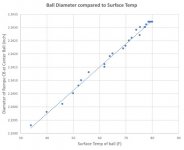
Data follows a linear trend line
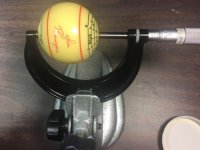
Starrett 2-3 inch micrometer in a stand used for meaurments. All diameters taken with the micrometer anvil and spindle touching the Rempe center ball figures.
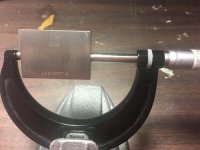
2 inch Webber gage block (super accurate) used to verify micrometer calibration.
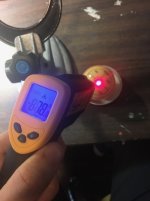
Infrared thermometer used to measure surface temperature of the ball. Also used it to measure the micrometer frame.
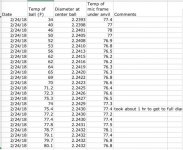
Raw data.
I used a Rempe ball, instead of one of my nice sets, incase the rapid expansion and contraction would cause any of the inlays to shift. There was no damage evident to the Rempe ball. However, I believe all of the Rempe markings are painted on, and not inlaid (I'm not sure of this).
Enjoy!

Data follows a linear trend line

Starrett 2-3 inch micrometer in a stand used for meaurments. All diameters taken with the micrometer anvil and spindle touching the Rempe center ball figures.

2 inch Webber gage block (super accurate) used to verify micrometer calibration.

Infrared thermometer used to measure surface temperature of the ball. Also used it to measure the micrometer frame.

Raw data.
Last edited: